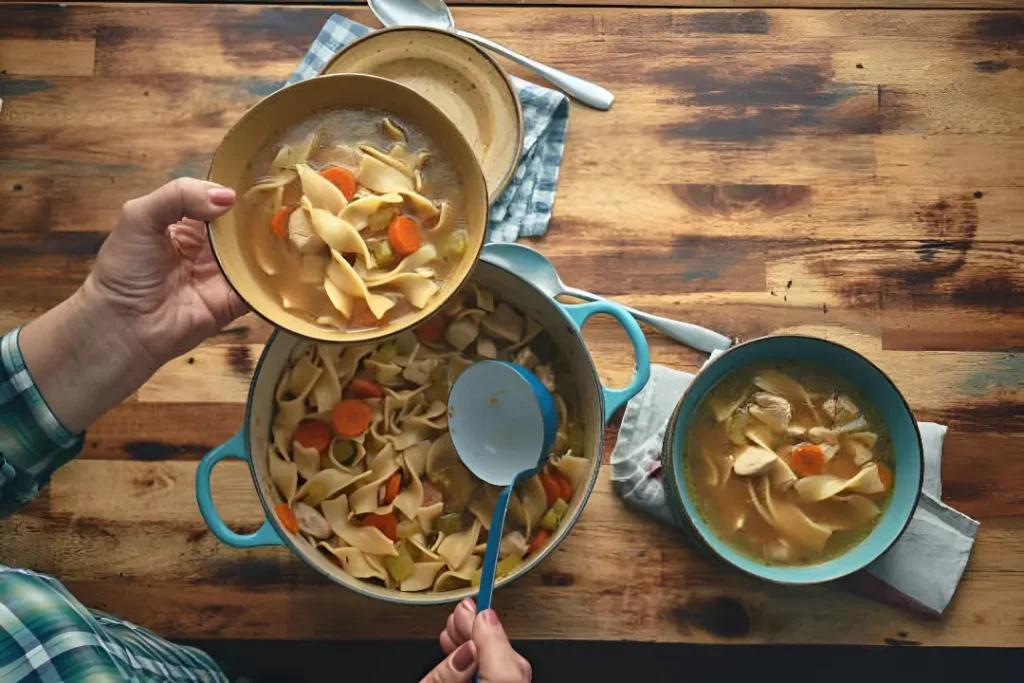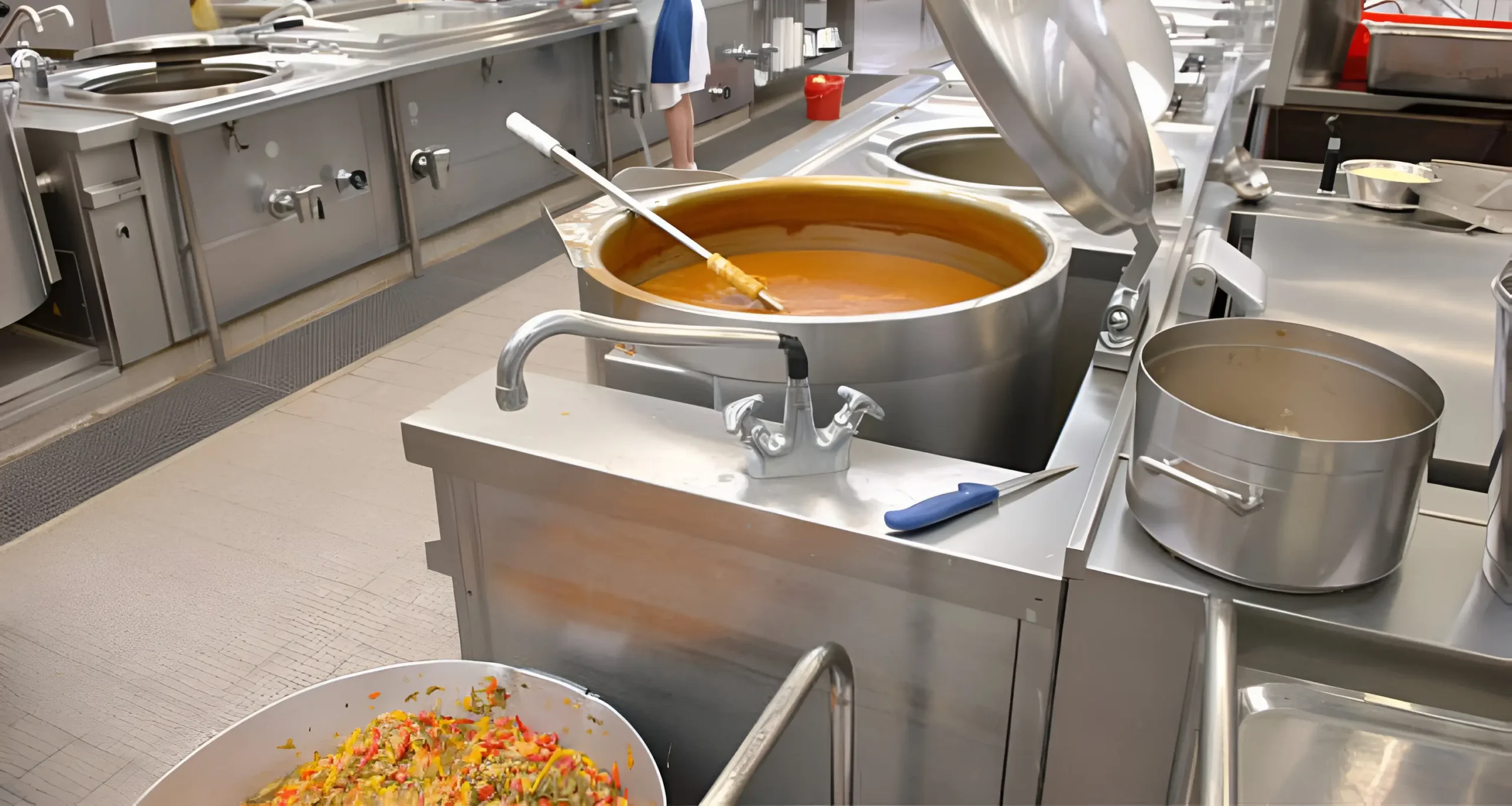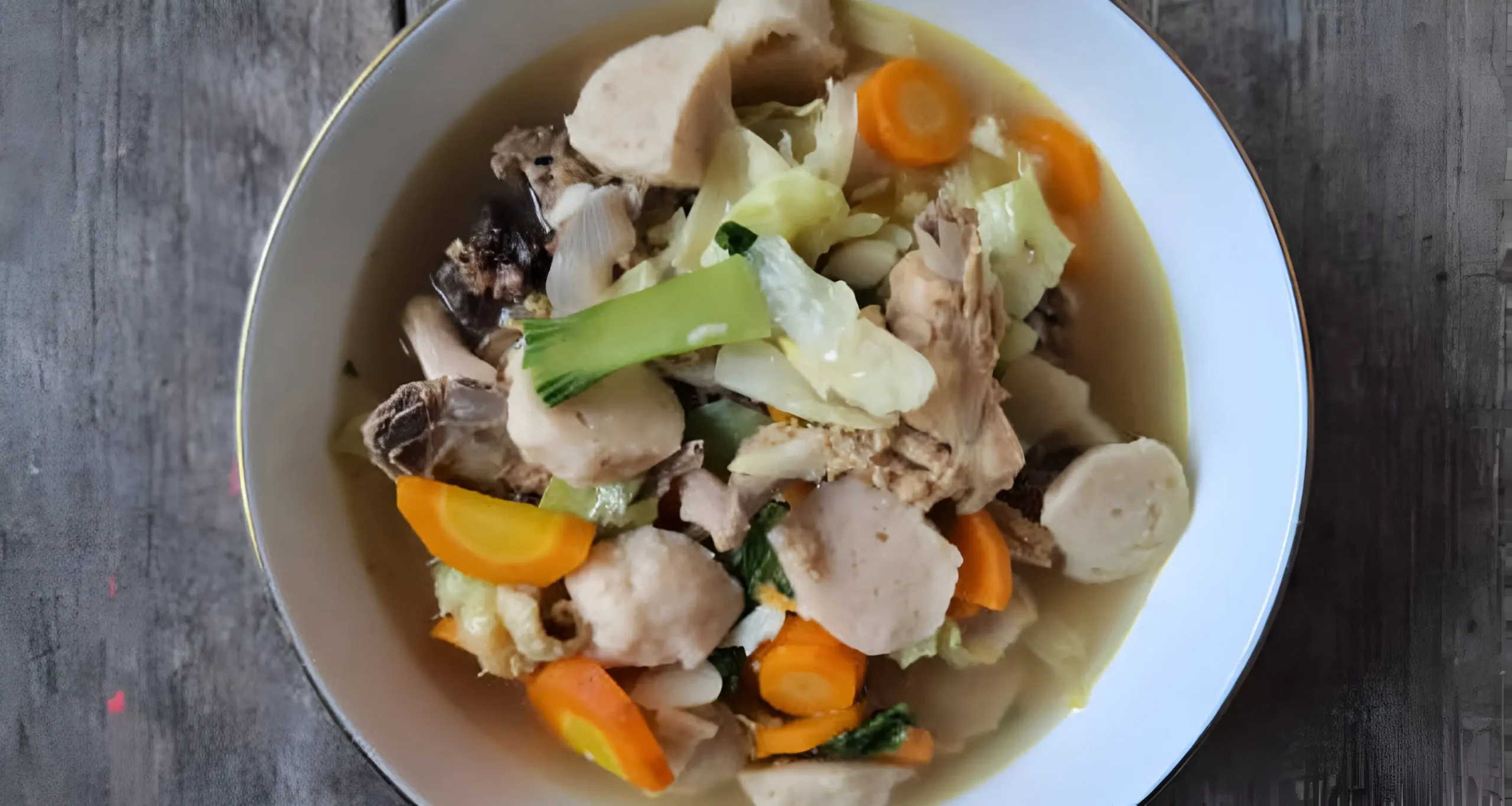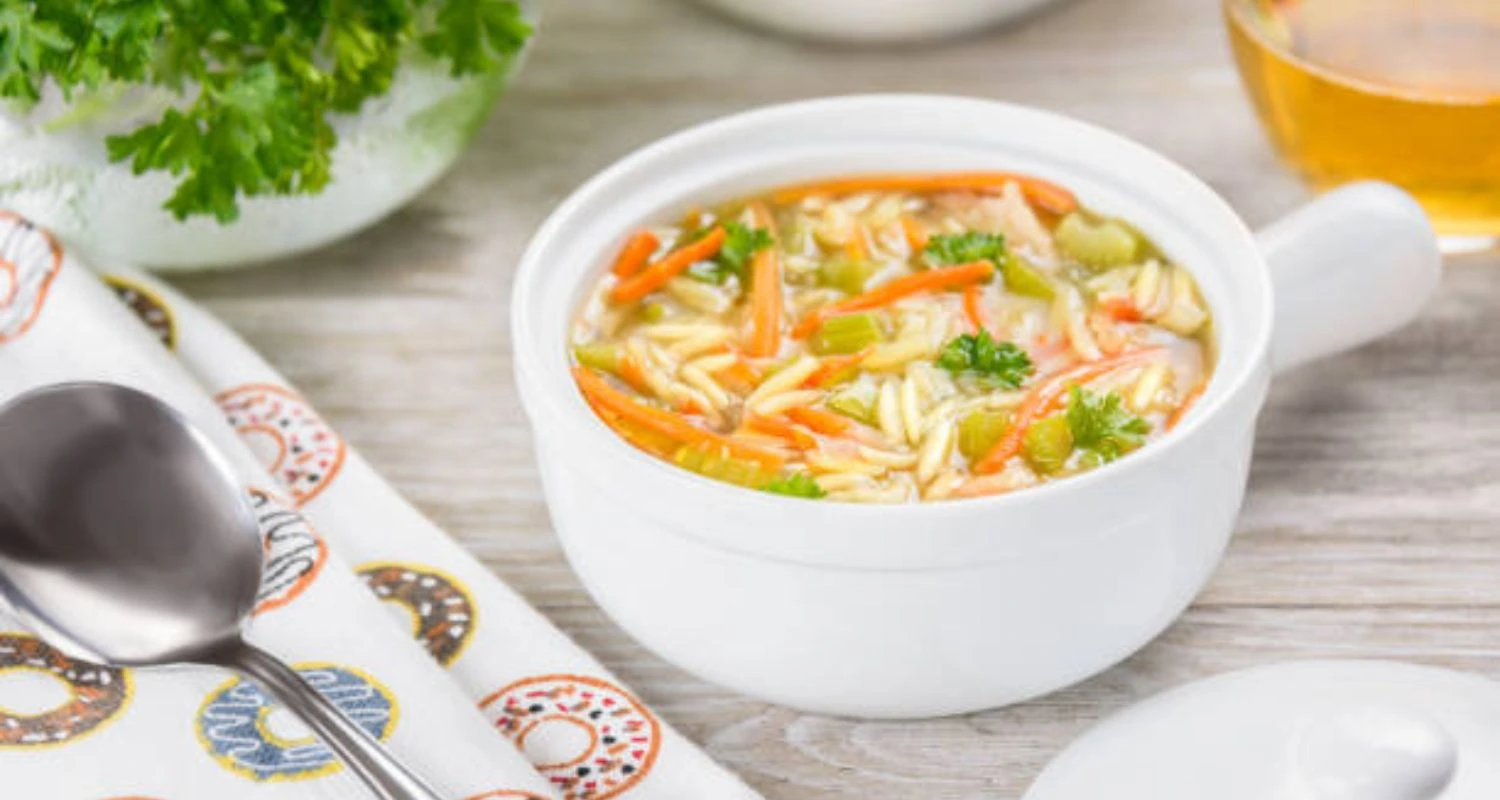Savor grandma’s chicken soup: Timeless Homestyle Comfort

grandma’s chicken soup is more than just a meal. It’s a warm hug that connects families across generations. Every spoonful brings comfort and healing. Your family’s chicken soup recipe is filled with love, tradition, and care.
This dish is special. It’s not just about food. When you make grandma’s chicken soup, you’re keeping a family tradition alive. Every step, from chopping veggies to seasoning, tells a story of home and heritage.
Looking for comfort during cold season or a taste of childhood? Grandma’s chicken soup is here for you. It offers warmth and satisfaction. Learn how to make the perfect bowl of comfort that has been loved for generations.
Key Takeaways
- Grandma’s chicken soup represents cultural and family traditions
- Every recipe carries emotional connections and memories
- The soup provides both nutritional and emotional nourishment
- Preparing the recipe connects generations
- Comfort food plays a significant role in family bonding
The Heritage Behind Grandma’s Classic Chicken Soup Recipe
Grandma’s chicken soup is more than a meal. It’s a tradition passed down through generations. Each family has its own story, with recipes that hold deep emotional and cultural value.
The warmth of grandma’s chicken noodle soup is unmatched. It’s a symbol of comfort, healing, and love. Families worldwide have used this dish to care for both body and soul.
Cultural Significance Through Generations
Chicken soup has been a universal remedy for centuries. Different cultures have made their own versions:
- Jewish communities call it “Jewish penicillin”
- Mediterranean families add aromatic herbs for extra healing
- Asian cultures include specific medicinal ingredients
“A good soup attracts neighbors” – Old Russian Proverb
Family Traditions and Love in Every Bowl
Every pot of grandma’s chicken noodle soup has a story. The secret ingredients are not just herbs and spices. They are memories, techniques, and love mixed into every batch.
| Cultural Origin | Unique Soup Characteristics |
|---|---|
| Eastern European | Rich, heavy broth with root vegetables |
| Mediterranean | Light broth with lemon and herbs |
| Asian | Ginger and green onion infused |
Grandma’s chicken soup is more than a recipe – it’s a warm embrace that transcends time and culture.
Essential Ingredients for Authentic Grandmas Chicken Soup
Making grandma’s chicken noodle soup starts with picking the right ingredients. The quality of your soup depends on using fresh, top-notch parts. These elements add warmth and comfort to every bite.
The base of a true chicken soup is premium ingredients. You’ll need to gather a few key items:
- Fresh whole chicken or quality chicken parts
- Farm-fresh vegetables like carrots, celery, and onions
- High-quality egg noodles
- Aromatic herbs from your garden or local market
Your grandma’s chicken noodle soup recipe needs special ingredients. These ingredients turn simple parts into a magical dish. Each one is important for creating rich, layered flavors that feel like home.
Choose crisp, colorful vegetables for your soup. Fresh carrots should snap when broken, and celery should have a vibrant green color. The quality of your ingredients affects the soup’s taste and health benefits.
Regional differences can change what ingredients you use. Some families add parsnips or use special herb blends. Your grandma’s chicken noodle soup might have unique touches that make it special to your family.
“The secret is in the ingredients you choose and the love you put into preparing them.”
Remember, authentic chicken soup is more than a recipe. It’s a tradition that connects generations through nourishing, tasty food.
The Perfect Chicken Selection for Your Homemade Soup
Choosing the right chicken is key for grandma’s chicken soup. The chicken’s quality affects the soup’s taste, richness, and overall feel. The right choice can turn a simple recipe into a special meal that warms your family’s hearts.
When picking chicken for grandma’s chicken soup, several factors are important. They can make your cooking better.
Fresh vs. Rotisserie Chicken Options
- Fresh Chicken: Gives you control over seasoning and texture
- Rotisserie Chicken: Is convenient and has a pre-developed flavor
Fresh chicken lets you control the salt and seasonings. Rotisserie chickens, though, are seasoned before and add a deep flavor to your soup.
Bone-in vs. Boneless Considerations
| Chicken Type | Broth Richness | Cooking Time |
|---|---|---|
| Bone-in Chicken | Extremely Rich | Longer Cooking |
| Boneless Chicken | Moderate Richness | Quicker Preparation |
“The bones are where the magic happens in a truly spectacular chicken soup.” – Culinary Tradition
Bone-in chicken makes a richer broth because of collagen and marrow. Boneless chicken cooks faster but misses the flavor depth that grandma’s soup is known for.
Fresh Vegetables That Make the Difference
Making grandma’s chicken noodle soup starts with picking the right veggies. The soup’s taste comes from using fresh, top-quality produce. This adds depth and nutrition to every bite.
Classic veggies are the heart of grandma’s chicken soup. Each one is key to creating rich, complex flavors. These flavors take you back to your childhood.
- Carrots: Add natural sweetness and vibrant orange color
- Celery: Provides earthy undertones and aromatic base
- Onions: Create depth and savory background notes
But don’t stop at the classics. Try adding other veggies to make your soup even better:
- Parsnips: Introduce subtle nutty sweetness
- Leeks: Offer mild, delicate onion-like flavor
- Turnips: Bring unexpected complexity to your soup
Choose fresh, seasonal veggies for the best taste. Opt for locally sourced, organic produce. It will make your soup taste better and be healthier.
| Vegetable | Flavor Profile | Nutritional Benefit |
|---|---|---|
| Carrots | Sweet, Mild | High in Vitamin A |
| Celery | Earthy, Crisp | Low Calorie, High Fiber |
| Onions | Savory, Pungent | Antioxidant Properties |
The secret to a memorable grandma’s chicken noodle soup is in the veggies. Take your time to chop them right and cook them perfectly.
Secret Herbs and Seasonings for Traditional Flavor
Making grandma’s chicken noodle soup just right means knowing how to season it. The right mix of herbs and spices turns a basic soup into a special dish. It warms your heart and makes your taste buds happy.
Choosing the right herbs and spices is key to a great grandma’s chicken noodle soup. The right seasonings can make the soup go from good to amazing.
Mediterranean Herb Combinations
Mediterranean herbs add a fresh and lively touch to your chicken soup. Here are some classic herb mixes:
- Fresh parsley for a bright, clean taste
- Dill for a subtle tangy flavor
- Oregano for depth and complexity
- Rosemary for an aromatic twist
Classic American Seasoning Blends
Traditional American seasonings give your chicken noodle soup a cozy and familiar taste:
| Herb/Spice | Flavor Profile | Recommended Amount |
|---|---|---|
| Bay Leaves | Earthy and subtle | 1-2 whole leaves |
| Thyme | Slightly minty and dry | 1 teaspoon dried |
| Black Pepper | Sharp and warming | 1/2 teaspoon ground |
Try out these herbs and spices to make a signature flavor that’s all your own. The trick is to find the right balance. You want the herbs to enhance the chicken broth without overpowering it.
Step-by-Step Cooking Process for Perfect Results

Making grandma’s chicken soup needs focus and patience. It starts with a solid base that turns simple items into a special meal.
Choose a big, heavy pot for even heat. This helps in making the soup’s flavors rich. Get your ingredients ready to make cooking smooth.
- Prepare chicken by cleaning and cutting into appropriate pieces
- Chop vegetables uniformly for consistent cooking
- Heat olive oil in the pot over medium heat
- Sauté aromatics like onions and garlic until fragrant
- Add chicken and brown slightly for enhanced flavor
Liquid is key in any soup. Add water or chicken stock slowly. This lets the ingredients blend well. Low and slow brings out the best flavors.
| Cooking Stage | Temperature | Estimated Time |
|---|---|---|
| Initial Sautéing | Medium Heat | 5-7 minutes |
| Simmering | Low Heat | 60-90 minutes |
| Final Seasoning | No Heat | 5 minutes |
Season slowly while cooking, tasting and adjusting. This makes the soup balanced and satisfying. It will warm everyone’s hearts and souls.
Mastering the Art of Clear Chicken Broth
Making a clear grandma chicken soup takes skill and focus. The key to a clear broth is knowing how to skim and control the temperature. These steps turn a simple soup into a work of art.
Skimming Techniques for Impeccable Clarity
Skimming is key for a clear grandma’s chicken noodle soup broth. Here are some tips to get rid of impurities:
- Start with cold water to help proteins coagulate
- Use a fine-mesh skimmer or spoon
- Remove foam and fat from the surface gently
- Skim continuously during the first hour of cooking
Precision Temperature Control
Temperature control is essential for a perfect grandma chicken soup. Here are some important tips:
| Cooking Stage | Recommended Temperature | Purpose |
|---|---|---|
| Initial Heating | 180-190°F | Slowly extract flavors |
| Simmering | 160-175°F | Maintain protein structure |
| Final Cooking | Low heat | Prevent ingredient breakdown |
By learning these techniques, you’ll make a broth as good as a restaurant. It will capture the true taste of homemade chicken soup.
Noodle Options and Cooking Times
Choosing the right noodles can make grandma’s chicken noodle soup recipe amazing. Different noodles add unique textures and flavors to this classic dish.
When picking noodles for your homemade soup, consider these popular options:
- Egg Noodles: Traditional choice for classic grandma’s chicken noodle soup recipe
- Wide pasta noodles
- Thin vermicelli
- Gluten-free rice noodles
Cooking times vary by noodle type. Thin egg noodles cook in 3-4 minutes. Wider pasta noodles take 6-8 minutes. Always cook noodles separately to keep them from getting mushy in the soup.
Pro tip for your grandma’s chicken noodle soup recipe: Add noodles just before serving. This keeps them perfectly textured. Overcooking can make noodles soggy and unappetizing.
“The secret is in the noodles” – Every grandmother’s cooking wisdom
For those with dietary restrictions, try gluten-free options like rice noodles or zucchini noodles. These choices let everyone enjoy a warm, comforting bowl of chicken soup.
Storage Tips and Reheating Methods

Keeping grandma’s chicken soup fresh is key. Whether you’ve made a big batch or saved leftovers, the right storage and reheating can make all the difference. This way, you can enjoy your homemade soup at its finest.
Storing your soup right is essential. Here are some tips to keep it tasting great:
- Refrigerate soup within two hours of cooking
- Store in airtight containers
- Keep refrigerated for up to 3-4 days
Freezing Guidelines for Later Use
Freezing is a great way to save grandma’s chicken soup for later. Follow these steps for the best results:
- Cool the soup completely before freezing
- Use freezer-safe containers or heavy-duty freezer bags
- Leave about 1 inch of space at the top for expansion
- Label containers with the date of preparation
- Freeze for up to 4-6 months
Maintaining Flavor and Texture
When reheating grandma’s chicken soup, be gentle. This helps keep its taste and texture just right. Here’s how to do it:
- Stovetop method: Reheat on low heat, stirring occasionally
- Microwave method: Use medium power and stir every 30 seconds
- Add a little water or broth if the soup seems too thick
- Avoid boiling, which can make chicken tough and vegetables mushy
Pro tip: If you’ve frozen noodles with the soup, add fresh noodles when reheating. This way, your grandma’s chicken soup will taste as good as when you first made it!
Health Benefits of Homemade Chicken Soup
Grandma chicken soup is more than a tasty comfort food. It’s a health powerhouse filled with nutrients. Your grandma’s recipe is a healing mix that boosts your body’s defenses.
The homemade chicken soup has amazing health benefits:
- Boosts immune system function
- Reduces inflammation
- Supports hydration
- Provides essential nutrients
Studies show grandma’s soup is a true medicine. Chicken helps fix body tissues. Vegetables add vitamins and minerals that boost your immune system. Warm broth clears nasal passages and keeps you hydrated when sick.
Experts say each ingredient has special benefits. Carrots give beta-carotene, onions fight germs, and chicken is lean protein. Together, they make a superfood for health.
Feeling sick? Nothing beats grandma’s chicken noodle soup. It’s not just food; it’s a blend of love, tradition, and science.
Serving Suggestions and Accompaniments
Enhancing your grandma’s chicken noodle soup recipe is more than just serving it. The right sides can turn a simple meal into a special occasion. Your soup needs thoughtful pairings that match its warm, comforting taste.
Traditional Side Pairings
Classic sides can make your grandma’s chicken noodle soup even better. Here are some timeless choices:
- Crusty sourdough bread
- Buttered saltine crackers
- Homemade cornbread
- Simple green salad with vinaigrette
Modern Serving Ideas
Get creative with your soup presentation with these new ideas:
| Serving Style | Recommended Additions |
|---|---|
| Rustic Presentation | Serve in ceramic bread bowls |
| Gourmet Touch | Garnish with fresh herb pesto |
| Texture Enhancement | Sprinkle toasted pine nuts |
For drinks, try light white wines or crisp apple cider with your soup. Remember, how you present your grandma’s chicken noodle soup is just as important as its taste.
Troubleshooting Common Soup-Making Challenges
Making grandma’s chicken soup can sometimes be tricky, but don’t worry! Every home cook faces challenges when making this classic dish. Knowing how to solve common problems will help you make the perfect soup every time.
Flavor and Texture Solutions
When your chicken soup lacks depth, try these quick fixes:
- Add a pinch of salt to enhance overall flavor
- Simmer longer to develop richer taste
- Incorporate fresh herbs near the end of cooking
Dealing with Specific Soup Issues
Tough chicken can ruin your grandma’s chicken soup experience. To ensure tender meat, choose the right cooking method:
- Use low, steady heat
- Check chicken internal temperature
- Remove chicken before it becomes stringy
“The secret to great soup is patience and attention to detail.” – Grandmother’s Kitchen Wisdom
Cloudy broth often frustrates home cooks. To keep your soup crystal clear, follow these tips:
- Skimming foam during initial boiling
- Using cold water when starting
- Avoiding vigorous stirring
With these troubleshooting tips, you’ll master the art of creating delicious, comforting chicken soup. It will rival your grandmother’s cherished recipe.
Conclusion
Grandma’s chicken soup is more than a meal. It’s a journey through family history and love. Your kitchen becomes a special place where old recipes come to life. They turn simple ingredients into a nourishing dish that connects us all.
Whether you follow a family recipe or make your own version, the goal is the same. It’s about comfort, healing, and enjoying every bite.
Every batch of grandma chicken soup has its own story. You learn how to pick the best chicken and make the broth clear. You also choose herbs that go well together. This makes your soup warm and real.
Cooking is an art passed down through generations. Your own touch makes each recipe unique.
Your cooking journey doesn’t stop here. Try new ingredients and techniques. Share your soup with family and friends. Cooking together creates memories that last a lifetime.
Your grandma’s chicken soup is a symbol of love and care. It shows the power of home-cooked meals.
Begin your soup-making journey today. Get your ingredients ready. Let the delicious smells of grandma’s chicken noodle soup fill your home with love and memories.
FAQ
What makes grandma’s chicken soup so special?
Grandma’s chicken soup is more than just food. It’s a family tradition filled with love and comfort. Each recipe is unique, thanks to homemade broth and personal touches.
How long can I store homemade chicken soup?
You can keep homemade chicken soup in the fridge for 3-4 days. Use an airtight container. For longer storage, freeze it for 4-6 months. Always cool the soup first and follow food safety rules.
Can I make grandma’s chicken soup with rotisserie chicken?
Yes, rotisserie chicken is a great shortcut. It might change the flavor a bit, but it’s quicker. Just add the chicken later to avoid overcooking.
Is chicken soup really good for fighting a cold?
Chicken soup has been shown to help with cold symptoms. The warm broth hydrates, and the veggies add nutrients. The steam can also clear your nose, making it a soothing remedy.
What are the best vegetables to use in chicken soup?
Carrots, celery, and onions are classic choices. But you can also try parsnips, leeks, or turnips for more flavor. Choose fresh veggies to make the broth rich and satisfying.
How can I make my chicken soup broth clear?
To get clear broth, start with cold water and simmer gently. Skim off foam and avoid boiling hard. Strain the broth through a fine-mesh sieve for a clear result.
Are there gluten-free noodle options for chicken soup?
Yes, there are many gluten-free options. Try rice noodles, zucchini noodles, or gluten-free pasta. You can also skip noodles or add quinoa for protein.
What herbs work best in traditional chicken soup?
Herbs like parsley, thyme, dill, and bay leaves are traditional. Mediterranean recipes might add oregano. Classic American soups often use black pepper, thyme, and bay leaves. The right mix enhances the soup’s flavor.
Add a Dash of Your Thoughts!
There are no reviews yet. Be the first one to write one.






